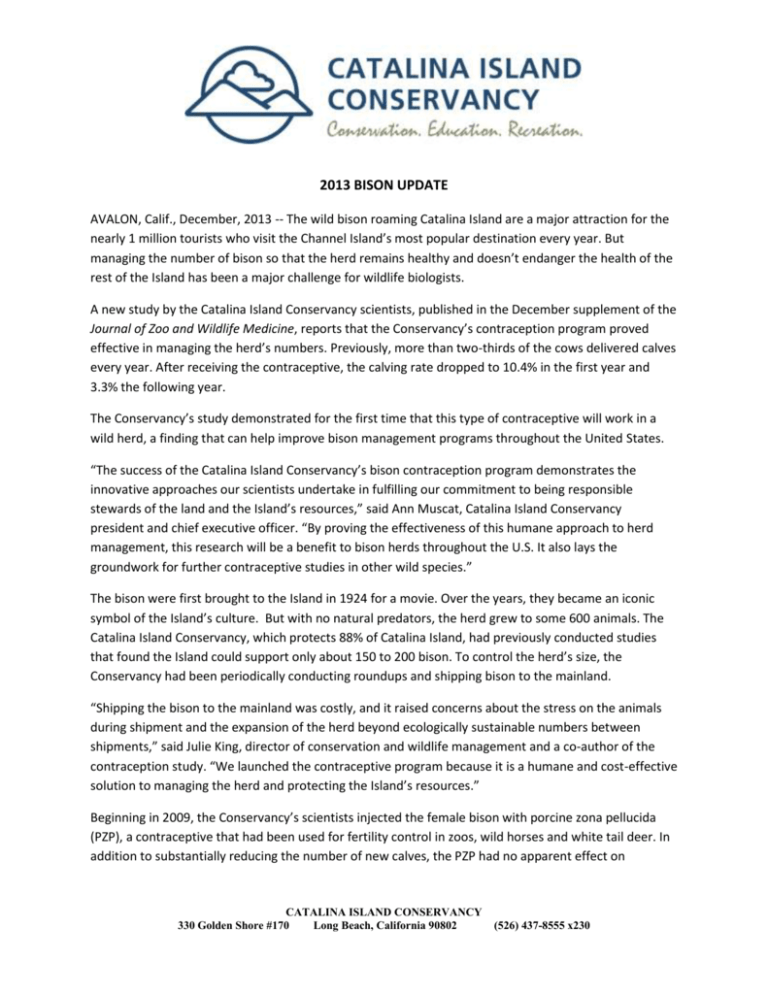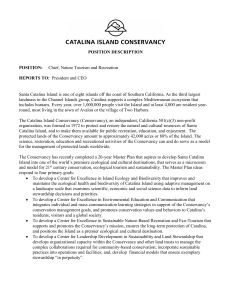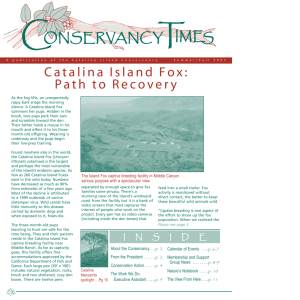2013 BISON UPDATE AVALON, Calif., December, 2013 -
advertisement

2013 BISON UPDATE AVALON, Calif., December, 2013 -- The wild bison roaming Catalina Island are a major attraction for the nearly 1 million tourists who visit the Channel Island’s most popular destination every year. But managing the number of bison so that the herd remains healthy and doesn’t endanger the health of the rest of the Island has been a major challenge for wildlife biologists. A new study by the Catalina Island Conservancy scientists, published in the December supplement of the Journal of Zoo and Wildlife Medicine, reports that the Conservancy’s contraception program proved effective in managing the herd’s numbers. Previously, more than two-thirds of the cows delivered calves every year. After receiving the contraceptive, the calving rate dropped to 10.4% in the first year and 3.3% the following year. The Conservancy’s study demonstrated for the first time that this type of contraceptive will work in a wild herd, a finding that can help improve bison management programs throughout the United States. “The success of the Catalina Island Conservancy’s bison contraception program demonstrates the innovative approaches our scientists undertake in fulfilling our commitment to being responsible stewards of the land and the Island’s resources,” said Ann Muscat, Catalina Island Conservancy president and chief executive officer. “By proving the effectiveness of this humane approach to herd management, this research will be a benefit to bison herds throughout the U.S. It also lays the groundwork for further contraceptive studies in other wild species.” The bison were first brought to the Island in 1924 for a movie. Over the years, they became an iconic symbol of the Island’s culture. But with no natural predators, the herd grew to some 600 animals. The Catalina Island Conservancy, which protects 88% of Catalina Island, had previously conducted studies that found the Island could support only about 150 to 200 bison. To control the herd’s size, the Conservancy had been periodically conducting roundups and shipping bison to the mainland. “Shipping the bison to the mainland was costly, and it raised concerns about the stress on the animals during shipment and the expansion of the herd beyond ecologically sustainable numbers between shipments,” said Julie King, director of conservation and wildlife management and a co-author of the contraception study. “We launched the contraceptive program because it is a humane and cost-effective solution to managing the herd and protecting the Island’s resources.” Beginning in 2009, the Conservancy’s scientists injected the female bison with porcine zona pellucida (PZP), a contraceptive that had been used for fertility control in zoos, wild horses and white tail deer. In addition to substantially reducing the number of new calves, the PZP had no apparent effect on CATALINA ISLAND CONSERVANCY 330 Golden Shore #170 Long Beach, California 90802 (526) 437-8555 x230 pregnant females or their offspring. The Conservancy’s scientists continue to study PZP to determine if the female bison can regain their fertility after a period of time without the contraceptive. “The bison contraception program is a good example of trying to reach a balance with cultural, aesthetic or recreational needs and uses and cost-effective natural resource management to maintain the health of the ecosystem,” said John J. Mack, chief conservation and education officer. “Because humans have been living and changing the Island for thousands of years, the Conservancy is always seeking new approaches to ensuring the long-term use and ecological health of Catalina Island." The study’s authors are Calvin A. Duncan, Julie King and Jay F. Kirkpatrick. Financial support was provided by the Offield Family Foundation, Harold McAlister Foundation, Wendy P. McCaw Foundation, Donald Slavik Family Foundation, Marisla Foundation and In Defense of Animals. CATALINA ISLAND CONSERVANCY 330 Golden Shore #170 Long Beach, California 90802 (526) 437-8555 x230











